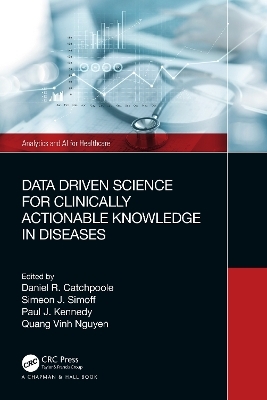
Data Driven Science for Clinically Actionable Knowledge in Diseases
Chapman & Hall/CRC (Verlag)
978-1-032-27351-8 (ISBN)
Data-driven science has become a major decision-making aid for the diagnosis and treatment of disease. Computational and visual analytics enables effective exploration and sense making of large and complex data through the deployment of appropriate data science methods, meaningful visualisation and human-information interaction.
This edited volume covers state-of-the-art theory, method, models, design, evaluation and applications in computational and visual analytics in desktop, mobile and immersive environments for analysing biomedical and health data. The book is focused on data-driven integral analysis, including computational methods and visual analytics practices and solutions for discovering actionable knowledge in support of clinical actions in real environments.
By studying how data and visual analytics have been implemented into the healthcare domain, the book demonstrates how analytics influences the domain through improving decision making, specifying diagnostics, selecting the best treatments and generating clinical certainty.
Daniel R. Catchpoole is the Group Leader of the Tumour Bank, Children’s Cancer Research Unit, Children’s Hospital, Westmead, Australia. He is also affiliated with the Faculty of Medicine at the University of Sydney and the Department of Information Technology at the University of Technology Sydney. Simeon J. Simoff is the Cluster Pro Vice Chancellor (Science, Technology, Engineering and Mathematics) and Dean of the School of Computer, Data and Mathematical Sciences at Western Sydney University. Paul J. Kennedy is the Director of the Biomedical Data Science Laboratory at the Australia Artificial Intelligence Institute and the Head of Computer Science in the Faculty of Engineering and Information Technology at the University of Technology Sydney. Quang Vinh Nguyen is the Director of Academic Programs for Postgraduate ICT at the School of Computer, Data and Mathematical Sciences and the MARCS Institute for Brain, Behaviour and Development at Western Sydney University.
Chapter 1. Understanding the Impact of Patient Journey Patterns on Health Outcomes for Patients with Diabetes. Chapter 2. COVID-19 Impact Analysis on Patients with Complex Health Conditions: A Literature Review. Chapter 3. Estimating the Relative Contribution of Transmission to the Prevalence of Drug Resistance in Tuberculosis. Chapter 4. A Novel Diagnosis System for Parkinson’s Disease Based on Ensemble Random Forest. Chapter 5. Harmonization of Brain Data across Sites and Scanners. Chapter 6. Feature-Ranking Methods for RNA Sequencing Data. Chapter 7. Graph Neural Networks for Brain Tumour Segmentation. Chapter 8. Biomedical Data Analytics and Visualisation—A Methodological Framework. Chapter 9. Visualisation for Explainable Machine Learning in Biomedical Data Analysis. Chapter 10. Visual Communication and Trust in the Health Domain.
| Erscheinungsdatum | 12.12.2023 |
|---|---|
| Reihe/Serie | Analytics and AI for Healthcare |
| Zusatzinfo | 25 Tables, black and white; 38 Line drawings, black and white; 21 Halftones, black and white; 59 Illustrations, black and white |
| Sprache | englisch |
| Maße | 156 x 234 mm |
| Gewicht | 470 g |
| Themenwelt | Mathematik / Informatik ► Informatik ► Datenbanken |
| Mathematik / Informatik ► Informatik ► Theorie / Studium | |
| Medizin / Pharmazie ► Medizinische Fachgebiete | |
| Studium ► Querschnittsbereiche ► Epidemiologie / Med. Biometrie | |
| Naturwissenschaften ► Biologie | |
| ISBN-10 | 1-032-27351-8 / 1032273518 |
| ISBN-13 | 978-1-032-27351-8 / 9781032273518 |
| Zustand | Neuware |
| Informationen gemäß Produktsicherheitsverordnung (GPSR) | |
| Haben Sie eine Frage zum Produkt? |
aus dem Bereich


